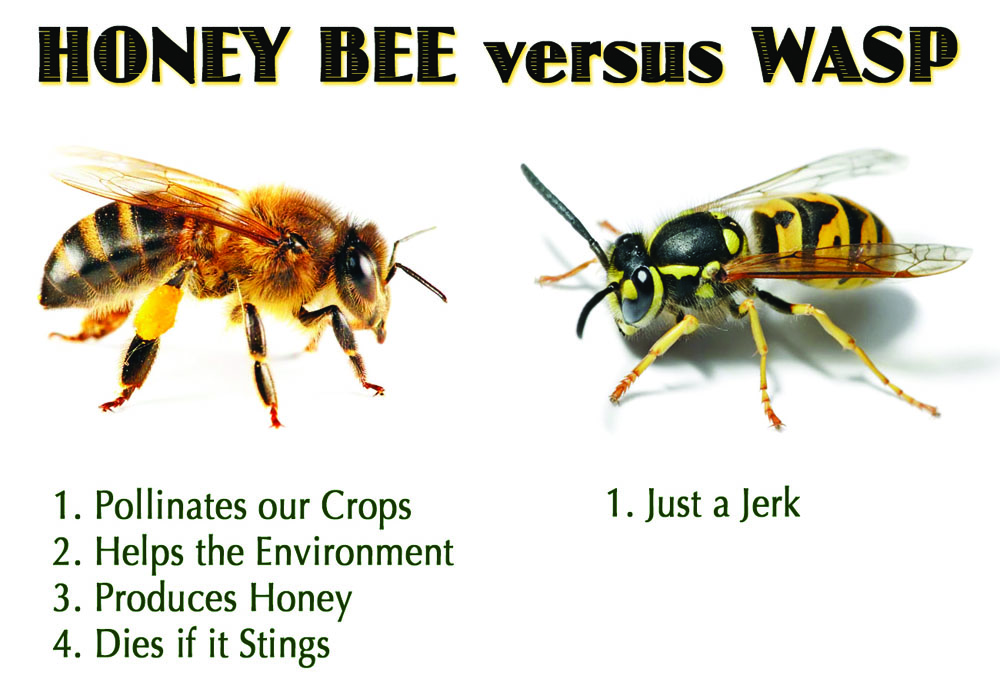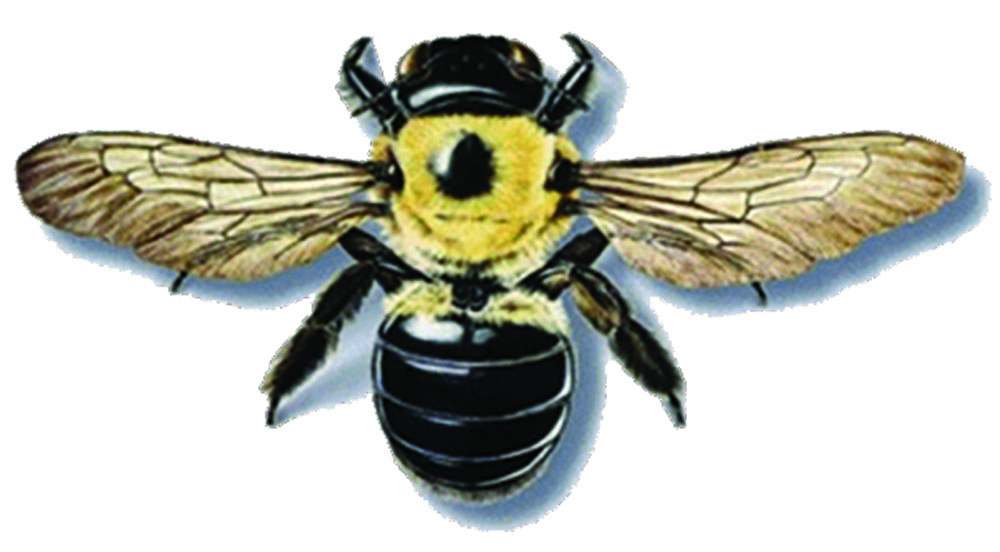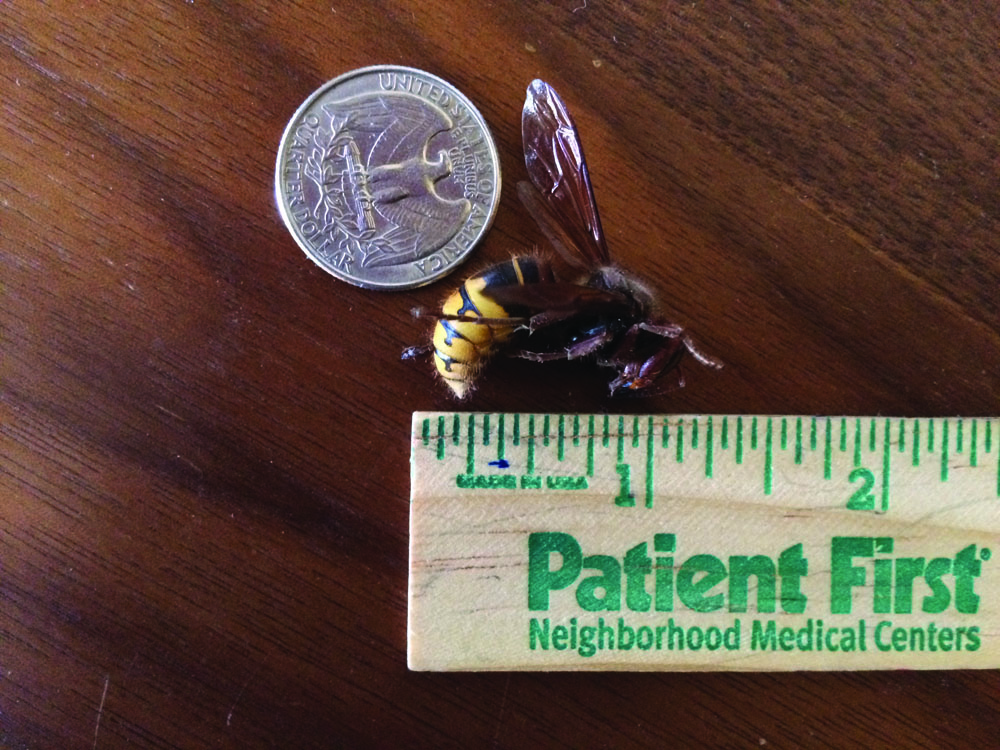by Toni Burnham
There’s an image floating around the Internet (kind of like the one here) that compares honey bees and wasps, and uses R-rated language, but it might just represent the dawn of a brave new day. What day is that? The first of a season where everything that buzzes is not a “bee,” and every “bee” is not an airborne hazard to public safety. It has been exciting to see it popping up in places not run by and for beekeepers, and to see that most versions mostly contain accurate (if limited) information.
You see, this is not an article about native human city dwellers, but about native bees, a vast and daunting task for which managing Apis mellifera is not much preparation. But as in most beekeeping stuff, one door always seems to open another, and the bees are patient instructors. Our daily management tasks may apply only to the European honey bee, but in making a place for them in the city, it has proved worthwhile to learn how to make major connections and distinctions between these bees and those bees. And those NOT bees!
This is a complicated topic. In the United States, official publications frequently estimate about 4,000 bee species: this is a moving target, as new species are identified and others potentially become extinct. Hereabouts, experts estimate about 2,000 species and have identified over 400, but good numbers are hard to come by. Native bees are not associated with commercial crops (so there are few dollars chasing them), and completing a census requires deep expertise and considerable effort. So you are going to find a comprehensive list hard to find.
Everything that Buzzes is Not a Bee
Because we are beekeepers, however, we are likely to be considered the local authority on the insect kingdom, but not so much that folks would like us to go on too long about how honey bees are different. As a kid, my first impression of beekeepers was that they were overly specific, uber-geeky hair splitters. Always piping up with “That’s not a bee, that’s a wasp!” or some such. A reasonable person like me would never be so pedantic.
Well. Huh.
The usual reasons I deploy for going to this additional form of urban effort – i.e. learning which bees, hornets, and wasps your neighbors are likely to encounter – are things you may have come to expect from these columns. In situations where there is a “bee” problem, urban beekeepers stand a decent chance of being blamed for it, and restrictions may result. Also, when we know enough to help people with a bee problem – even one that has nothing whatsoever to do with managed bees – beekeepers become a valued asset to the neighborhood. Third, many urbanites get into beekeeping for environmental reasons, we want to help, and providing the information that protects natives and even extends their habitat is beneficial to all. Finally, there is even a fourth reason this time: if we can spot and flag a true safety problem and help resolve it, we can save pain and, potentially, lives.
Here’s a story about the impact of ignorance: last year, Samantha took our short course, and set up her woodenware in a really lovely place in her yard – she’s one of the lucky ones with a setback to die for that is actually a good location for bees. Sam opted to wait for a nuc rather than go with an early package, so her empty hive bodies sat out there for much of April and May. A week or so after the boxes were placed, however, the city got a barrage of phone calls from her next door neighbor claiming that children were being stung left and right, and ER visits had resulted. The neighbor’s yard was actually infested with yellow jackets, and even after this was pointed out, suspicious mutterings to the effect that the hive had somehow “attracted” wasps kept Sam biting her nails. Her neighbors needed to stop blaming Samantha, and start understanding the impact some gardening choices (in this case, leaving piles of hay around) were having on the well being of their kids.
So all those beekeepers, over all those years, who kept jumping up every time and saying “That’s not a bee!” were making an important point about what happens when folks do not challenge, or are not invited to change, the thinking that “they’re all the same” and “they don’t belong here.”
Beekeeper as Bee killer?
We are all used to hearing fear come back at us when we broach the subject of urban bees. Therefore, it probably should not have been a surprise to see the kinds of questions that we receive (in the hundreds) every year from folks who just want to make all bees, beneficial or not, go away, when we publicly offer to collect swarms.
Though the downtown club website contains good information (including pictures!) on what is and is not a swarm, we get a lot of calls and emails. Less than one in 100 concerns honey bees or swarming (Note: For the general public–and some beekeepers who make me want to tear out my hair – “swarm” is a word that means “more than one, especially bugs,” and no photo or detailed description will convince them that a holly hedge undergoing energetic pollination is not a swarm).

I might complain to you, but we try to take these phone calls, get folks to describe what they are seeing, and tell them what they have on their hands. We try to help them not be afraid, and even become curious, with just a couple of questions like “What are you seeing?” and “Is anything blooming right now?” We want them to understand that we beekeepers did not create a problem here, that there is not even a problem here, and that we would like their help in protecting the cousins of our bees while they enjoy them, too.
Now that everyone seems to call from a cell phone, I keep a set of web links to helpful native pollinator pages (God bless you, Cornell Extension!) that are texted over with encouragement to see if that is something like what is going on. It makes one heck of an impression when we are right! We try to get people to be proud that they created healthy habitat, to feel like they are now stewards of gentle and beneficial ecological heroes, and to avoid pointless poison and expense. We have learned, over the years, which big native bee families are likely to become active, and then dormant, when, and in which order. There are some bigger species, notably Xylocopa, that make an outsized impression and receive special attention (see sidebar).
Considering that these bees are the ones that actually evolved in this ecosystem, and are individually better pollinators on the whole than the gals we are able to introduce, we really owe them some support and protection.
But taking into account the many climates, horticultural zones, and habitat features of North American cities, there’s just no way this article can guess at, let alone cover, the species most likely to co-occur with your urban honey bees. Get with your local extension office or cruise the web site of the entomology department of your nearest land grant university. The Pollinator Partnership (www.pollinator.org) is developing a state-by-state series of pollinator identification guides. Finally, most of the bee clubs around here have at least one serious beek
who has taken an interest in native pollinators, and may have a pretty good idea of what is going on. Like managing honey bees, local insight is everything, so don’t ignore a nearby human resource!
When discussing the main native pollinators we have, the points our call takers like to make are:
These bees belong here, and are an intrinsic part of the normal functioning of the ecosystem;
Native bees are often paired with native plants, and are active while the latter blooms, often just a couple of weeks. Then they are likely dormant;
Almost none of these species are interested in colonizing human houses, and since they don’t store honey and are active briefly, damage is unlikely;
Stinging is rare, often impossible, and usually the product of concerted human interaction;
For ground nesting species, eradication requires copious poison released into the environment or extensive excavation and is unlikely to work anyway; and
The ones that do the most hovering are usually males, and nature did not see fit to give them a stinger.
Later in the season, the calls will shift to a dicier discussion, as wasp and hornet nests come up to full strength. Not all habitat can be shared (see the yellow jackets, above) but it is amazing how many bald-faced hornet nests around here survive when folks learn that 1) no, beekeepers won’t take them; 2) the city does not do pest control on private property; and 3) they will have to pay someone if they are not content to let seasonal change and a hard frost take care of it. We keep the phone and the email of the Department of Health staff that are in charge of dealing with street tree nests, and an updated set of web links on “green” eradication. My friend Sean will, for a small amount of cash, come and bag a hornet nest and bring it to a wooded area to give it a chance.
Ever since that National Geographic film about killer Asian Giant Hornets (Vespa mandarinia) was released (Hornets from Hell, 2002), we get a question or two about European Giant Hornets (Vespa crabro) from time to time, mostly from folks who are scared out of their wits and wonder whether they should alert the authorities. The stings hurt, but they do not dissolve flesh.
It takes all kinds
We’ve had very few swarm calls this year, but we got one from a jogger who claimed a beekeeping relative and swore up and down there was a swarm settling in a yard northwest of here. Bee folks are getting antsy with so few freebies this Spring, so I took a chance and did a blast announcement to interested beekeepers that had signed up from that zip code. Probably half a dozen cruised by that front yard. A couple of beekeepers thought they saw someone home and knocked, but no one came to the door and I asked them to please refrain from getting arrested.
Later on, Nicole was passing by, and saw an older gentleman in the garden. She said she was a new beekeeper, and thought these looked like tiny honey bees: in fact, a number of beekeepers had been by to check them out! The gentleman, who was a recent widower, smiled and said, “Oh no, these are miner bees! They come out every year this time, buzz around for a couple of weeks, and are gone.” And then he said, “Thank you for caring.”
The Comedy of the Carpenter Bee

In case you don’t have them, Carpenter bees (genus Xylocopa) are an impressively large bumblebee-like pollinator with highly territorial and not terribly bright drones. Their numbers appear to have increased locally, and the drones’ habit of flying at any and all creatures in their chosen patch have made quite an impression. The drones are merely attempting to reserve all the females in these areas for themselves, and the females are mostly not seen. Their handiwork is, though: amazingly professional looking bore holes in soft wood, often with a tiny pile of sawdust underneath. Both the public and beekeepers seem to have it out for these marvelous pollinators, but local Master Beekeeper Dr. Wayne Esaias recently rose to their defense in a heated online discussion of their “misdeeds.”
“Some responders are needlessly perpetuating fear of bees, and are not helping with education on the matter. Carpenter bees are excellent pollinators, and are quite benign when one knows their behavior. The ‘damage’ is insignificant, but is used by home repair people to extract significant $$ from ignorant homeowners in addition to causing [unnecessary] pesticide applications.”
“At a very early age my parents showed me how to recognize drones by the conspicuous white spot between their eyes and to catch them bare-handed. My mom learned from her father. They’ve been nesting in the garage for over 75 years, and on a nice spring day there may be a dozen or more males ‘guarding’ their territory with nothing but bluster. Toss a dark pebble in the air and watch them succeed in ‘chasing it away.’ Face them head-on while they are hovering to confirm the white head, and make a quick grab.”
“The only time I was ever stung was when I grabbed a female (a.k.a. a black head) by mistake from behind. I guess I was getting cocky. In those days I tied a black thread to drones and sold them in school for 50 cents. Back in the mid 50s I got suspended for three days after one landed on the music teacher’s buxom chest while I was giving a tethered-flight sales demo. It landed on the point of closest approach, if you remember how mid-century undergarments were shaped, causing audible gasps from my buds and repeated shrieks from Mrs. Lee (who was a knockout, and whose efforts to remove bee from bosom caused 12-year-old males to gape).”
“With inflation, I bet they are worth $5 to $10 today. But from this perspective, that experience was priceless.”
“The two-car garage is still structurally very sound (albeit lighter) after 75 years of providing nesting sites. What they do is akin to the ‘honeycombing’ used extensively in the aircraft and aerospace industry to lighten material. Try telling an aeronautical engineer that honeycombing is ‘structural damage.’ Carpenters bees simply are not a problem for structural integrity based on my experience.”
“The female Carpenter bees keep a decent space between tunnels, preserving most of the strength. To this day, there is a ton or more of stuff stored on those cross beams. One reason for their thick gallery walls (3/16” or so) is to prevent parasitic wasps from ovipositing from the outside, and the Carpenter bees don’t want to make their nest unsound either. They are not like termites, which eat everything and can cause buildings to collapse. Galleries also get reused.”
“The biggest downside is a bit of sawdust on cars.”
“I am pleased to say they are in my shed and my grape arbor, and my grandkids will appreciate them. I know that education cannot cure all apiphobia nor prevent needless application of pesticides, but I felt a need to make an attempt. Fairly benign measures are the badminton racquet (although mostly only hovering drones will be smashed but it does make a rewarding sound) and plastic or aluminum flashing to let worrywarts sleep at night. But even then, erect some bare untreated wood structures (trellis, arbors) to attract them away and to replace nesting sites for a very good pollinator, and enjoy them. They will be gone in a few months.”








